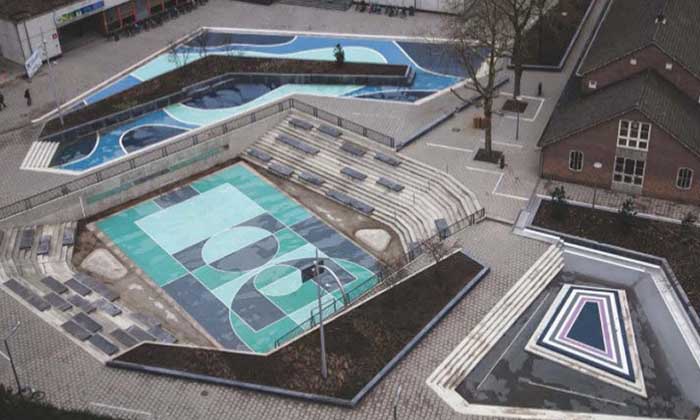Water – Holland’s ‘Frenemy’

18 February 2016

3.00pm – 5.00pm. Registration from 2.30pm, seated by 3.00pm

MND Auditorium
Resources
Lecture Poster (PDF: 334KB)
Lecture Report (PDF: 934KB)
Lecture Transcript (PDF: 446KB)Lecture Videos
Living with water: The Netherlands Urban design: Resilience and beauty Remaking living spaces: The social angle Utopian visions: Floating cities, salt cities Engineering change in urban design Rethinking water management
100RC’s City Resilience Framework
Synopsis
For centuries, the Dutch have been known for their prowess in conquering water in order to make their low-lying country habitable. Now, as the consequences of climate change are making themselves felt, the Netherlands are looking for new ways of working with nature to protect their manmade land. For the first time, engineers, urban designers and landscape architects are working together to redesign cities and countryside to create more space for water. Traditionally the enemy, water is gradually becoming a ‘frenemy’. And just as in the past, the world is looking to the Netherlands for forward-thinking, long-term solutions.
Lecture Report
“The issue of urban design for water is really becoming the forefront of urban design in general. I see the willingness to entertain ideas and as the problems become more urgent, the willingness – to try water solutions that will make life and cities more attractive and safer at the same time – is growing.”
Redesigning cities for resilience to climate events will involve mindset and cultural shifts as well as being open to innovation, says Tracy Metz, Director of the John Adams Institute in the Netherlands.
Metz, the author of Sweet and Salt: Water and the Dutch, was speaking at a CLC lecture on 18 February. On water issues from flooding to drought, she brought up innovative solutions from the Netherlands, Germany, South Korea and Singapore.
On a paradigm shift in the flood-prone Netherlands, where water management is centuries-old, she said: “You see that more and more water is being brought into the built environment. It’s a huge mindset change for engineers in particular, because the main concern was always safety and to keep the water out. Now the idea is that lowering the dikes, letting the water in, might be a safer way.
“The engineers now also have to work with landscape architects and with citizens who might also have an opinion about this. Many of these processes of negotiation, design and consultation are complicated, lengthy and labourious. But I think now people are starting to realise that this really could be worthwhile.”
Questioning the water management approaches of the past has opened the way for innovative ideas, Metz added. Traditional measures such as dikes, reclaimed land and storm surge barriers have mitigated the effects of floods in the Netherlands, but have also brought negative impacts to natural ecologies.
“You can’t intervene like this for centuries and then just be surprised when there are consequences,” she says. “(Today) the Netherlands is asking themselves, what is the next storm surge barrier that will keep the country safe, but still intervene less harshly in the natural system?
“We have paved over so much of the city, made the ground so hard and the water is running off so quickly. We need to make the city softer, greener and hold on to the water rather than letting it flow straight away into the sewer.”

The water plaza in Rotterdam allows for natural flooding during rains and activities when it is dry
An area in Rotterdam illustrates how urban design can adapt to changing conditions and educate the public. “The city purposely designed a bridge to disappear into the water (at high tide) to help people realise that this place can change character - sometimes it’s wet, sometimes it’s dry. We’re all trying to get people more aware of water issues and what these can mean for cities and for their own lives.”
Other innovative approaches Metz presented included water squares and urban infrastructure in Hamburg that accommodate changing water levels and the shifting of floodplain farms to higher ground for greater resilience and flexibility. Singapore’s Active, Beautiful and Clean (ABC) water projects such as the re-natured waterway of Bishan Park were also noted for their emphasis on the crucial aspect of public engagement and education.
Ending on a utopian vision, Metz discussed the ideas of Dutch architect Eric Geboers, whose The Salt Project conceptualises a city built of hardened salt, obtained from desalination, and operating on a circular economy.
Written by Alvin Chua.
About the Speakers
SPEAKER
Ms Tracy Metz
Director
John Adams Institute
Tracy Metz, a native of California, is a journalist, author and presenter based in the Netherlands. She is the director of the John Adams Institute, an independent foundation that brings the best and brightest of American thinking to the Netherlands. She writes about urban issues for the Dutch quality national newspaper NRC Handelsblad and the American magazine Architectural Record and was a visiting fellow at Harvard’s Graduate School of Design. Her most recent book is Sweet&Salt: Water and the Dutch, about the ‘extreme makeover’ of the Dutch landscape to accommodate a new, more natural relationship to water in times of climate change.